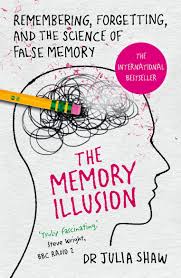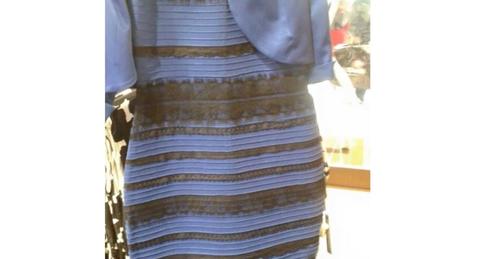Author: Julia Shaw
ISBN: 9781847947628
APA Style Citation
Shaw, J. (2016). The Memory Illusion: Remembering, Forgetting, and the science of False Memory. London: Random House Books.
Buy This Book
https://www.amazon.com/Memory-Illusion-Remembering-Forgetting-Science-ebook/dp/B019CGXQA8
| memory_illusion_activity.pdf |
| eidedic_memory_test.pdf |
| wiltshire_nissan.mp4 |
| whiltshire_rome_eidedic_memory.mp4 |
| stroop_effectactivity.docx |
| animalstroop.tif.pdf |
The author of The Memory Illusion, Dr. Julia Shaw, a forensic psychologist in the Department of Law and Social Sciences at London South Bank University, studies the creation of false memories and is a consultant on memory issues for the legal system, the military, and businesses. Dr. Shaw demonstrates how important memory is in a variety of contexts including the law, interpersonal communication, social media, personality and identity and the many ways in which our memory can be deceptive. By highlighting the latest research, the book demonstrates how understanding problems with memory can provide insight into ways in which memory can be improved.
Dr. Shaw is a leading expert in the area of autobiographical false memory, and her research involves creating false memories in her research participants. In one such study, Dr. Shae wanted to see if it was possible to create a false memory of committing a crime. The 100 participants in the study were told that they would be taking part in a study on actual memory and they are all aware that Dr. Shaw had spoken in advance with their parents to gain personal information about them. During the first visit, Dr. Shaw began by discussing an actual event in the life of the participant that was shared by his or her parents. Next, Dr. Shaw introduced the false memory of an event that resulted in police involvement, e.g., “your parents talked about a fight you had when you were in your early teens that was so severe that the police called your parents.” The false memory included a few details that were true as well such as the location of where the person lived at that age and the name of a friend from the time. The participants often reported that they did not recall this happening
Dr. Shaw then introduced some methods that are known to induce false memories such as visualization exercises. Dr. Shaw also introduced subtle social pressure by explaining that these methods work for most people if the subject tried had enough. On the second visit, one week later, it was found that over 70% of participants accepted the false memory that they had committed a crime. The participants typically began to add details by filling in details such as background information and what the scene looked and felt like. Participants, of course, were fully debriefed at the conclusion of the study. According to Shaw, “In essence, what I do is I get people to confuse their imagination with their memory.” Shaw’s research has numerous connections to the psychology curriculum, including the work of Elizabeth Loftus on the misinformation effect and the fallibility of memory as well as source amnesia and reality monitoring errors.
The book covers a wide range of memory research and memory phenomena including the problem of recalling childhood memories, the influence of perception on memory, the influence of memory on identity and sense of self, extremes of memory (e.g., individuals with highly superior autobiographical memory, savants), arousal and memory (Yerkes-Dodson law), memory and the legal system, the biology of memory, flashbulb memory, memory hacking, social media influences, and memory improvement. In one section, the author discusses the 2015 social media sensation of the dress (blue/black or white/gold) regarding memory and how it relates to perception. A video describing the dress controversy is listed in the other related resources section of the post.
Three scientific papers were published on this Internet phenomenon which is seen as one of the first clear examples of individuals looking at an identical physical stimulus, yet seeing it differently. The answer seems to relate to the perceptual idea of color constancy in which the visual system compensates for differences in lighting to have an understanding of color. The author illustrates how color constancy is informed by memory. Team white/gold saw the dress using color constancy based on a memory of items being dimly lit, and team blue/black saw the dress using color constancy based on a memory of items being better lit. Both teams of viewers combined perceptual visual information with memories of how objects appear in different types of lighting. The book also explains how the dress controversy and other examples illustrate the interaction of bottom-up and top-down (including memory) processing influence our implicit expectations about the world.
Shaw discusses a study she conducted in which participants were shown a picture of a “suspect” along with a short story about the crime they were accused of committing and then were asked to serve as jurors to decide if the person was innocent or guilty. The only evidence they had to make their decision was the photo, the short story and a written sheet of evidence. The stories and evidence were matched with photos by chance so that the researchers could determine if the jurors were impartially deciding on the evidence alone and not the photo. The photos were all previously rated on a scale of trustworthiness. The results showed that participants were more likely to be harsher when the face associated with the evidence was previously rated as low in trustworthiness. For a low trustworthiness face participant needed fewer pieces of evidence to assign guilt and less likely to change their mind after viewing exonerating information. Despite using the same evidence, the face of the suspect led to drastically different conclusions even with the same evidence indicating bias. If someone is completely innocent, they may still be convicted simply because they “look” guiltier.
The Memory Illusion includes interesting and surprising connections between memory and other areas of the psychology curriculum. In addition to a fascinating discussion of the topics in memory, the book also covers concepts from units including social psychology, research, biological bases, sensation and perception, learning, states of consciousness, personality, and motivation and emotion are included illustrating how the various fields of psychology are connected to the cognitive perspective. Students will also see through this book how psychology relates to a wide range of other fields including medicine, law, economics, business, politics, and the military.
Other Related Resources
National Geographic Episode – Interactive video to examine a variety of memory problems.
https://www.youtube.com/watch?v=RWO2UQ4MW7U
What Color is the Dress?
https://www.youtube.com/watch?v=AskAQwOBvhc
The Dresser: Color Constancy
http://uk.businessinsider.com/dresser-has-the-internet-arguing-over-its-color-2017-12?r=US&IR=T
Julia Shaw’s TEDx talk on How False Memories Corrupt Our Identities, Politics, and Justice System.
https://www.youtube.com/watch?v=J8j3FQOz310
Julia Shaw on “Memory Hackers” NOVA PBS documentary demonstrates her research on how it is possible to create false memories.
https://www.youtube.com/watch?v=NfPLTtlo2oY
Julia Shaw – Memory Hacking: The science of learning in the 21st Century at the Learning Technologies Conference on February 28th, 2017.
https://www.youtube.com/watch?v=ZU4suR_uXbg
Julia Shaw – Embrace Your Imperfect Memory.
https://www.youtube.com/watch?v=L71f71b1CL0
"Making Evil: The Science Behind Humanity's Dark Side." The new book by Dr. Shaw due out in 2019. A new book by the author of “The Memory Illusion.”
Julia Shaw’s 2015 paper titled, Constructing Rich False Memories of Committing a Crime published by the Association for Psychological Science.
http://nebula.wsimg.com/ce2babe46721a32c861f1a646c2836aa?AccessKeyId=AF62ECFBCD8F6D95BACE&disposition=0&alloworigin=1
Elizabeth Loftus’s TED Talk – How Reliable is Your Memory?
https://www.youtube.com/watch?v=PB2OegI6wvI
Elizabeth Loftus: Lost at a Shopping Mall
https://faculty.washington.edu/eloftus/Articles/sciam.htm
Beau Lotto’s TED Talk – Optical Illusions Show How We See
https://www.youtube.com/watch?v=mf5otGNbkuc
Picking Cotton: 60 Minutes episode on the wrongful conviction of Ronald Cotton and the fallibility of eyewitness testimony
https://www.youtube.com/watch?v=LkBiaI9PSQU
Psychological Figures and Concepts
Gordon Allport
Dan Ariely
Solomon Asch
Rene Descartes
Hermann Ebbinghaus
Sigmund Freud
Jerome Kagan
Daniel Kahneman
Eric Kandel
Joseph Le Doux
Elizabeth Loftus
Oliver Sacks
Nicholas Spanos
Amos Tversky
Robert Yerkes
Alzheimer’s disease
Amnesia
Amygdala
Auditory lobe
Autism
Backmasking
Behaviorism
Benzodiazepines
Bias (own age, own-gender, own-race)
Bottom-up processing and top-down processing
Brain region and memory (limbic system, frontal lobe, parietal lobe, temporal lobe, thalamus)
Change blindness
Chunking
Confabulation
Conformity
Dementia
Depression
Dissociation
DSM-5
Eidetic memory
Electroencephalography (EEG)
Emotion
Engram
Episodic memory
Eyewitness testimony
Face recognition
False memory
Flashbulb memory
fMRI functional magnetic resonance imaging
Forgetting
Hippocampus
Hypnosis
In-group bias
Innocence project
Inverted-U hypothesis
Language development
Long-term memory
Long-term potentiation
Maturation
Memory palace
Metamemory
Misinformation effect
MRI magnetic resonance imaging
Neurotransmitters (e.g., acetylcholine, GABA, glutamate)
Overconfidence
Parallel processing
Pineal gland
Plasticity
Post-traumatic stress disorder
Priming
Prospective memory
Prosopagnosia
Pruning
Psychoanalysis
Rapid eye movement (REM)
Schema
Semantic memory
Short-term memory
Source confusion
Super recognizer
Task switching
Theory of mind
Weapon focus effect


 RSS Feed
RSS Feed